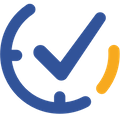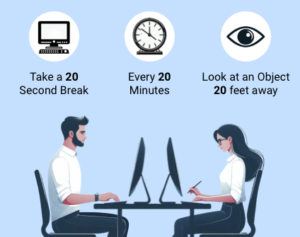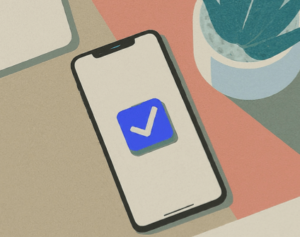In the whirlwind of today’s digital distractions, it’s too easy to get swept away in tasks and notifications. The 20/20/20 Rule can reclaim your focus and improve your productivity. Every 20 minutes, you take a 20-second break, releasing your gaze beyond the screen to something at least 20 feet away. Sounds simple, right? Join us as we dive deeper into this rule, and equip you with the tools to utilize its full potential.
Understanding The 20/20/20 Rule:
The 20-minute interval within the 20/20/20 rule holds importance as it reflects the concept of the “20-minute rule,” representing that human attention span tends to decline after approximately 20 minutes of uninterrupted focus. Without breaks, individuals face the risk of encountering reduced alertness and a high chance of errors. Sustained attention relies on cognitive resources that gradually deplete over time, as proposed by neuroscientists. Elements such as mental fatigue, reduced arousal levels, and habituation to stimuli contribute to this decrement in focus.
The recommendation to take a break for at least 20 seconds serves multiple purposes. It allows the eyes to relax and refocus, reducing strain and fatigue associated with prolonged screen viewing. According to studies, extended screen use can lead to symptoms of digital eye strain, including dry eyes, blurred vision, and headaches. By looking at something 20 feet away, the eye muscles responsible for focusing are given a chance to relax, promoting comfort and reducing the risk of developing eye-related discomfort.
The distance of 20 feet is significant because it falls within the range of optimal focusing distance for the human eye. The ciliary muscles in the eye, which control the shape of the lens to focus on objects at different distances, experience strain when constantly focused on nearby objects, such as screens. By looking at something 20 feet away, these muscles are allowed to relax into a more natural state, reducing strain and promoting visual comfort.

Practical Strategies:
Improving productivity and well-being in your daily routine requires practical strategies that seamlessly fit into your schedule, and technology provides numerous tools to assist with this endeavor. For instance, utilizing dedicated productivity apps like Trello or Planndu can help you organize tasks and set reminders for regular breaks. These apps allow you to create customized schedules, set timers for work sessions, and receive notifications when it’s time to take a break. Wearable devices like smartwatches or fitness trackers equipped with built-in reminders and activity-tracking features can serve as personal assistants, gently nudging you to step away from your screen and engage in rejuvenating activities every 20 minutes. You can improve your digital workflow seamlessly by installing browser extensions like Break Timer for Chrome or Eye Care 20 20 20 for Firefox, which prompt breaks directly within your web browser, facilitating the integration of the rule into your routine.
Augmenting relaxation during breaks is essential for maximizing productivity levels. Engaging in simple practices such as gazing at the horizon to relax eyes or close eyes and practicing deep breathing can assist with mental fatigue and concentration. Taking a moment to gaze into the distance allows the eye muscles to refocus and prevent eye tiredness. Similarly, practicing deep breathing helps calm the mind and reduce stress levels. Switching up your activities during breaks can help keep your mind fresh and energized. Instead of engaging in the same activity every break, consider incorporating a variety of relaxation techniques such as stretching, or listening to calming music. By diversifying your break activities, you can prevent monotony, maintain engagement, and optimize the rejuvenating effects of your breaks.

Implementing the 20/20/20 rule can sometimes be met with resistance, especially for those accustomed to continuous work without breaks. Overcoming this resistance and cultivating consistency is crucial for reaping the full benefits of the rule. To start, it’s essential to acknowledge that breaking the habit of uninterrupted work may feel challenging at first. The urge to power through tasks without pause can be strong, but recognizing the importance of incorporating breaks for physical and mental well-being is the first step toward change. Begin by incorporating short increments of the 20/20/20 rule into your daily routine. For example, commit to following the rule for just one hour each day initially, then gradually increase adherence over time. By starting with manageable goals, you can build momentum and gradually acclimate to the new habit of taking regular breaks.
With the 20/20/20 rule, you can protect your eye health and optimize your productivity and well-being in the long run. Finding the right balance between focused work and regular breaks can help to maintain efficiency and creativity in today’s screen-centric world. Incorporating this rule into your daily routine instills valuable habits of self-care and time management, laying the foundation for a healthier work-life balance.




